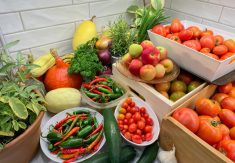Reuters / World grain prices should remain “very firm” over the near term as demand from Asia exceeds forecasts and dry weather cuts into supply, the senior economist of the UN’s Food and Agriculture Organization (FAO) said March 26.
South American corn and soy yields took a beating from drought this season, while China’s rapidly growing middle class continues its love affair with beef steaks. The shift in diet has held strong in the face of the country’s economic slowdown, underpinning demand for corn and soymeal used to feed cattle.
Read Also

What is perfect Christmas weather?
What is ‘perfect’ Christmas weather on the Prairies? Here’s where you should head this holiday, according to historical weather data.
“Demand is definitely growing faster than what we had expected, while supply ended up being less than we expected,” FAO senior economist Abdolreza Abbassian told Reuters three days ahead of the organization’s meeting of Latin American agriculture ministers in Buenos Aires.
“You put these two factors together and it explains what’s happening today with prices globally,” he said by telephone from his office in Rome while soybean futures on the Chicago Board of Trade explored six-month highs.
“In the near term — this month and next — we are going to still see very firm prices,” said the economist. “What happens after that depends on crop development and the weather.”
Macroeconomic factors
As South America harvests its 2011-12 soy and corn, U.S. and European growers are heading into planting season.
“A few months ago we were expecting slower growth in demand,” Abbassian said. “Macroeconomic factors were making us believe that demand in feed use, for example, would grow at a slower pace. But I think we always underestimate the growth in emerging countries, in Asia in particular.”
World food prices hit records last year, helping to spawn the Arab Spring revolts that toppled the governments of Egypt, Libya and Tunisia. Prices have since fallen but their upturn in the first two months of 2012 is raising inflation concerns.
“The fact that the prices of certain crops are approaching the peaks of last year tells you something about market direction and sentiment,” Abbassian said.
The United Nations had expected soy prices to start falling by this point in the year. But the market remains nervous about early-season dryness in Europe, North Africa and the Middle East.
“Unpredictability in prices is increasing,” Abbassian said. “If the Chinese feel that corn prices could still rise, they may surprise us and buy more, which would send prices up. Considering the agitation in the market, this could lead to panic buying.
“If we would have had this conversation a few weeks ago I would not have even considered this as being in the cards,” he added.














